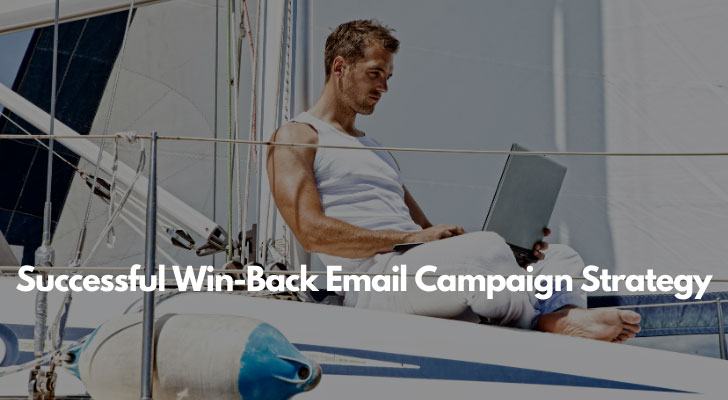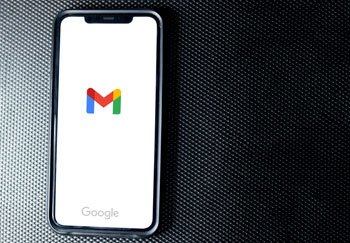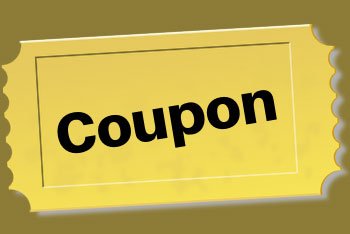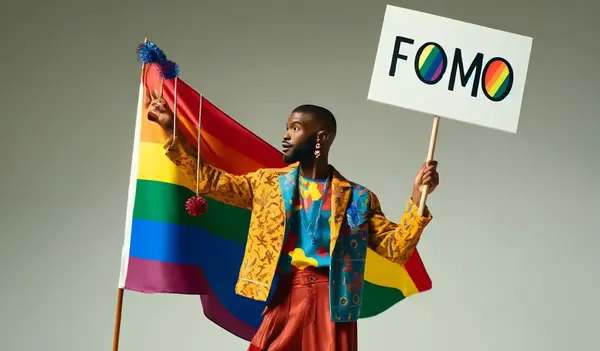Different brands have their unique customers, with varying levels of interaction. Some clients significantly engage with your products and services while some don't. From the high level of interactive customers, some are loyal to and patronize you regularly.
Another set of customers are those referred to as advocates. They may not buy as much as the loyalist, but they advertise your products to their sphere of contact. The last category is lapsed and unengaged customers.
This group of people probably patronized you once but have not connected with your brand in a long time. There is no need to worry about them, as every business has them, including the big names.
Rather than fretting about unengaged clients, you should be asking how you can win and bring them back to the fold. This is where a win-back email campaign comes into play. But what does it mean? Keep reading to find out.

What Is a Win-Back Email Campaign?
A win-back email — also referred to as a re-engagement campaign — is a message sent to non-interactive customers to re-engage them. The campaign uses an automation sequence that begins with a gentle nudge and incentives.
The email targets those who purchased or engaged with your products or services at least once in the past. You direct them to those who haven't opened an email from you or visited your website within a given time frame.
Most brands consider a customer inactive if they have not felt their presence for at least six months. However, note that depending on the services you render or the product you sell, it might be longer, like years.
For example, a company that sells basic life necessities will expect more return customers than those in the automobile industry. While the former would send win-back emails within weeks or months, a car dealer may wait years.
Thus, before embarking on a win-back email campaign, check the frequency your clients will go through your purchased products. If you render services, check how often they will need your assistance.
Why Should You Send Win-Back Emails?

If your customers are not buying from you, they are patronizing someones else, most likely your competition. Since businesses and profits are all about people, you must strive to win back your clients.
If you ignore all non-interactive customers, you lose out on the sales you can make. You will also miss the opportunity to make them loyal clients and advocates of your brand.
Conversely, if you send win-back emails to everyone on your mailing list, it could negatively affect your deliverability. Despite the preceding, it is more beneficial to send re-engagement messages.
The emails will let your customers know you haven't forgotten about the time they patronized you. It might trigger them to visit your website or make a purchase, or might address their concerns.
If the above doesn't convince you about the importance of win-back emails, then the next sentence might. Keeping and acquiring new customers is vital to your ROI and growing your business reach.
It costs five times more to get new clients than to keep them. Thus, it is essential to do all you can to retain the ones you have. Win-back campaigns are the way to go. Not only will it improve sales, but it also increases your customer lifetime value.
The next question then becomes how you can create these messages to get a win. This article will address it next.
Also Read: AW Pro Tools Review – They Make A HUGE Difference
Compelling Win Back Email Strategies for Your Customers
Having established what a win-back campaign is and why you need one, the next thing to do is look at some compelling strategies. Here are useful tips to keep in mind:
Use an Alluring Subject Line
Basically, an email is a message, and if you've ever sent one, you know it must have a subject line that draws attention. It's the first thing that your leads see when they receive an email, and if it's not enticing enough, chances are they will ignore them.
Since you're dealing with people who have not opened your emails in a long time, it would be tougher to get them to read the content. The only way to get through this barrier is by creating a subject line so catchy it piques their curiosity.
Some brands have used words like "We Miss You," or "It's Been a While" to evoke interest in inactive customers. Using words like that tells the reader that you noticed their absence, and their presence means a lot to you.
You don't have to use those exact words, but ensure that it reflects your brand and makes your message feel targeted. Test your win-back emails subject lines to see if they work and their success rate. Stick with what resonates with your customers and discard what doesn't.
Send Appropriate Win-Back Messages
The biggest problem brands encounter is deciding on the type of emails to send and when to forward them. For a typical email win-back campaign, you can send five messages in a sequence that is bound to evoke a response from the reader.
Why five, you may wonder? It's because sending one means you only make a single attempt, which has less chance of working. However, beyond the number of emails you send, their content is critical.
It must contain the appropriate message from the first to the fifth email for your win-back campaign to work. The following are the different kinds of messages to send:
1. The Hello Win-Back Email

Believe it or not, the messages brands send to their customers on events like birthdays or anniversaries mean a lot to them. Although they are automated, several people look forward to receiving them.
This is because human nature craves appreciation and acknowledgment. It's the same for a win-back email. When you send the "Hello" message, you're not only reminding people that your brand exists, you're saying you noticed their absence.
Your customers want you to acknowledge their patronage, and according to various Consumer Censuses, the majority of consumers want recognition for their loyalty. Doing this keeps them with you and away from your competitor, who is just a click away like a mail-order bride site.
Saying "Hello" also reminds your customers why they chose your product first and shows them the exciting new features. Ensure that:
- The message is simple as inactive customers are not looking to read a lot of content from you.
- It reminds clients of the incredible benefits your product or service provides.
- The email contains a low friction call-to-action; it should sound polite and not demanding.
- The message has the "Awww Factor;" something that evokes an emotional response in the reader's heart.
- It has the customer's information if possible. Try to make it less generic and more centered on a particular person.
2. The Incentive Win-Back Email
If the hello win-back campaign doesn't work, there's no need to fret. First, not everyone will respond to that type of message, as people react to things differently. Second, it means you have to up your game, and nothing works better than an incentive.
According to ActiveCampaign, 80% of people who join your mailing list do so to know when you have a promo ongoing or offer discounts. With this in mind, you can add an incentive to trigger the inactive customer's interest. You can do this by offering;

- Coupons
- A bonus gift
- Free shipping
- Extra reward points
- Free upgrades
- Personalization
- Free consultation
- Sweepstakes and prizes
The incentive should be about your brand and your capabilities. If your business model doesn't support incentives, then offer something related. A gift card would work fine here.
When sending the incentive win-back email, ensure that it offers your customers something they want. Create a sense of urgency by fixing a timeline; it will evoke a quicker response.
3. The Feedback Win-Back Email
This is all about getting information. Your goal is to find out why your customers left. Emails of this nature serve two essential purposes:
- They show that customer satisfaction is your top priority. If used rightly, it might win your clients back.
- They help you improve your emails, eCommerce, and customer service.
People love to give opinions; they like to say what they think you are doing wrong and what they expect as a solution. Asking them for feedback allows them to do that and interact with your email.
Bad customer experience is a business killer and one of the most common reasons people switch brands. It can be the reason why your hello and incentive win-back emails didn't work.
When sending feedback emails, ensure that:
- You give your customers a reason to respond like an incentive.
- You are direct and straight to the point. Time is a valuable asset, so don't beat around the bush or try to be coy.
- You are emphatic. Empathy will always take you a long way as people want to know you care and don't just see them as a meal ticket.
4. The Cleaning House Win-Back Email Campaign
If the first three don't work, then it's time to go all-in with an ultimatum. At this point, either you win back your customers, or you lose them forever. It's practically the last thing you have in your arsenal to convince a customer to re-engage with you.
The cleaning house win-back campaign will help you:
- Identify those who no longer want to connect with you, and you can let them go;
- Identify those whose hearts are still with you, and you can try to win them back with a future campaign.
- Clean the list of inactive subscribers, which improves your deliverability rate and reduces bounce backs.
You don't lose out completely; you leave to try another day. When sending cleaning house win-back emails, keep the content light and playful. Let the customer know what they'll lose by unsubscribing, and allow them to decide.
5. The Unsubscribe Win-Back Email
When everything else fails, you can let go, but send one last goodbye message. Chances are, the other emails met the customer on a bad day, and they are in a better place to receive your news now.
An unsubscribe win-back email can recapture a customer's attention and get them to re-engage with you again. Ensure that the message is not impersonal. It should show that you hate to let them go, and the choice is entirely theirs to stay if they desire.
In summary, the email should:
- Give your customers the benefit of the doubt, as mistakes happen and the person didn't mean to unsubscribe.
- Give customers options; they can choose to switch from daily newsletters to weekly or monthly.
- Be real; avoid including false information.
- Keep the door open. Let your customers know you're willing to add them back to your mailing list if they decide to rejoin.
What Else Can You Do?

When embarking on a win-back campaign, note the frequency of the emails. Don't bombard those you're trying to win back with messages. Set timers, and give the customers enough time to respond.
Furthermore, you can use the FOMO effect to get your customers back. Being in tune with the recent trends is a must for most people. You can trigger this desire when trying to win them back.
Lastly, before sending win-back email campaigns, note the last time the customer bought from you and their order's frequency. Also, look into the average order value, like if it's low, medium, or high.
Start Winning Back Your Customers!
Attempting to win back inactive customers can seem like a daunting task, and for the most part, it is. However, if you have an effective win-back email campaign to fall back on, it would be much more comfortable.
You don't have to type the messages yourself, as win-back messages are mostly automated. They effectively reach out to customers once they hit their inactivity threshold. Don't forget to include an enticing subject line.
Once you've taken the first step with the targeted campaign, be assured that you can recover more customers. Remember everything discussed in this article, and don't leave any out. Implement them to the letter, and your conversion rates will improve significantly.


